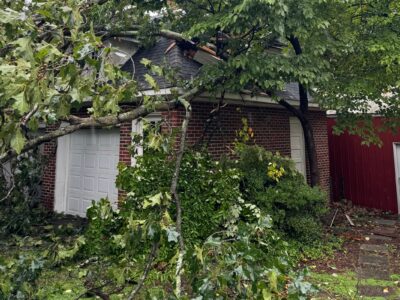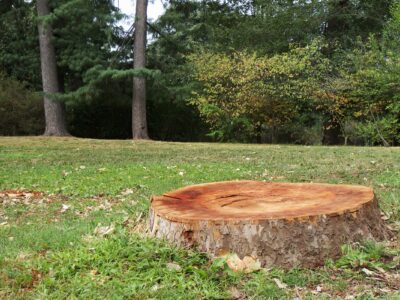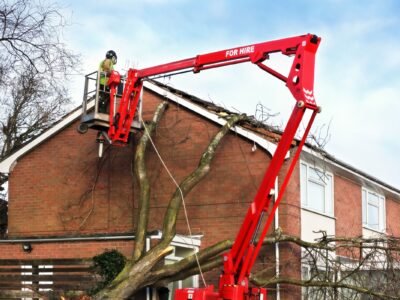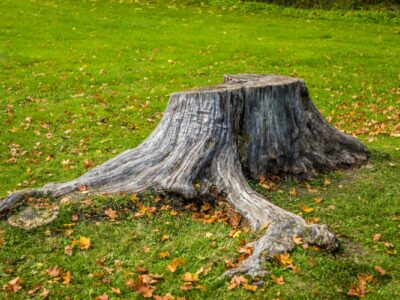How to Revive a Dying Tree in Winston-Salem: Signs of Stress and What to Do Next
June 11, 2025
Worried you might have a dying tree on your hands? Don’t panic; read about the signs to look for and the steps you can take to restore your sick tree to health.
Now that summer has settled into Winston-Salem and you’re spending increasingly more time outside enjoying the lush greenery of your property, you’ve noticed your favorite shade tree is yellowing and dropping leaves. But, before you abandon hope and schedule a removal for your dying tree, consider the steps you can take to preserve it.
Though it can be difficult to discern the root cause of the stress, you’ll be relieved to know: it is possible to revive a dying tree — whether the damage is due to disease, pests, or weather-related trauma.
Key Takeaways
- A sick tree is not automatic cause for panic or an immediate tree removal service; depending on the type and severity of damage, it is possible to revive a dying tree.
- The common signs of a sick or dying tree are cracking, splitting, or peeling bark; overly moist soil; leaf discoloration; sporadic dieback; abnormal growths; and more.
- The specific conditions that affect tree health in Winston-Salem are the increased heat, humidity, and drought risk during the summer months, along with the general soil composition.
- Consulting a professional, ISA-Certified Arborist familiar with the unique conditions of Winston-Salem will give you the best chance of successfully restoring your tree’s health.
Signs of Sick or Dying Trees
Perhaps one of the hardest and most frustrating aspects of overall tree care and maintenance is learning to read their symptoms.
Sure, sometimes it’s obvious that your beloved tree has been plagued by irritating pests or is suffering from a disease (i.e. visible insect infestation or drastic evidence of illness), but that is not always the case. Often, you just notice the result of some underlying issue affecting your tree’s ability to thrive with no clear clue of the culprit. And while some signs of a dying tree are detectable by an untrained eye, others may be harder to spot and require a careful evaluation from a Certified Arborist.
If you fear one or more of your trees are suffering from an unseen danger, check for the following telltale signs:
- Overly moist or soggy soil indicating moisture retention and poor drainage
- Discrepancies in the bark such as unnatural cracking, splitting, peeling, crumbling, or falling from the trunk
- Visible insect presence indicating severe infestation
- Branches, sticks, and twigs dropping frequently
- Clear evidence of tree fungus or rot
- Fresh or open wounds where the tree was improperly pruned or a branch broke
- Deep gaps in the trunk’s bark revealing the soft, vulnerable inner wood underneath
- Problems with the leaves (such as excessive dropping or not leafing out like normal)
- Brittle branches that are easy to snap (if they have already fallen from the tree; do not look for branches to test as this could cause unnecessary stress, especially in summer months)
- Prevalence of cankers: the unsightly knobs or protrusions of excessive bark
To ensure that your sick tree does not become a dead tree, it’s important to act quickly when you notice symptoms of distress. In many cases, when caught early enough, a dying tree can be nursed back to health with the right treatment plan (and a little bit of TLC, of course!). However, keep in mind that if your tree remains untreated for an extended period and/or exhibits numerous distress signs, it may be too late to save it.
How Stress Can Impact Tree Health & Presentation
In the same way that it can be difficult to notice the symptoms of a dying tree, it’s not always evident whether the issues stem from pests, disease, or something else entirely.
Leaf scorch, for instance, one of the Winston-Salem area’s most common tree diseases, is often confused for heat stress or drought symptoms because the presentation is similar. Both weather-related trauma and leaf scorch result in discoloration and premature leaf dropping, but the latter is identified by the specific yellow or reddish-brown patches that appear on the edges of older leaves.
Similarly, a tree experiencing dieback (a condition where portions of the tree canopy droop and die with no apparent cause) could be suffering from external forces such as poor weather conditions or problems with the soil or roots. Without a professional assessment from a trained arborist, it can be virtually impossible to know what exactly is making your tree sick. There are, however, some signs that generally indicate what category your issues fall under:
Evidence of Disease
Usually, if a tree is suffering from some sort of bacterial or fungal disease, the exhibited symptoms are holistic — affecting more than one area of the trunk and canopy with varied symptoms. Some of these include:
- Discolored or wilting leaves
- Signs of root rot such as stunted growth, development of cankers or other fungal infections on the trunk, sporadic branch dieback, or a leaning/unstable tree
- Visible growths or protrusions forming on the trunk
- Powdery white mildew developing on branches and leaves
Evidence of Pests
Depending on the specific type and severity of pest presence or infestation, the noticeable damage tends to be a bit more localized to the affected area of the tree. Here are some clues you’re likely dealing with an irritating insect problem:
- Visible insects throughout the tree trunk, branches, and leaves (the specific location depends on the type of insect; i.e. caterpillars attack the leaf tissue, while wood-boring insects affect the wood itself)
- Bark damage and discrepancies, including holes, peeling, cracking, etc. in no apparent pattern
- Discolored or spotted leaves
- Premature leaf drop
Evidence of Weather-Related Stress
Some weather-related stress or tree damage is obvious — a large branch snapped off in a storm or a previously upright tree now with a significant lean and exposed roots — but a lot of weather-induced tree trauma in Winston-Salem can be confused with signs of pests or diseases. Besides monitoring your trees after an intense storm, pay attention to the following symptoms, too:
- Wilting, yellowing, and browning leaves throughout the tree canopy can indicate heat stress
- Cracking or shrinking throughout the trunk’s bark particularly in drought periods
- Shifting or swelling soil around the base of the tree trunk demonstrates high wind damage over time
Notice how many of the signs and symptoms overlap? Because it’s often too difficult to discern the precise cause of decline, the best course of action is to consult an arborist to help revive your dying tree That way you can be sure the steps you take actually address the root problem and begin the path to recovery.

An up-close view of an infected oak leaf. Robert L. Anderson, USDA Forest Service, Bugwood.org
Causes of Tree Stress in Winston-Salem
Here in Winston-Salem, we’re blessed to experience all four seasons throughout the year. But, while we’re able to quickly adapt to changing temperatures and various weather conditions, our trees do not have the same luxury. Understanding the way our climate impacts overall tree health is important in ensuring your outdoor plants remain happy and healthy.
Increased Heat & Humidity
Just like humans, trees can suffer from scorching heat and humidity. The high temperatures we regularly experience over the course of the summer can cause increased transpiration, the process of water evaporation from a tree’s leaves. When too much water leaves the tree, the entire structure begins to dry out — causing droopy, discolored leaves and brittle twigs and branches.
Conversely, a higher level of humidity can lead to fungal growth and create a breeding ground for various pests. Thus, finding the right balance between too much moisture and not enough is essential in keeping your tree well-quenched throughout the hot southern summer.
Increased Chance of Droughts
While higher temperatures are often accompanied by increased humidity levels, Winston-Salem also experiences a rise in drought risk over the summer; just last year our community saw the worst seasonal drought since 2008. Unfortunately, our hottest months often tend to be our driest when it comes to rainfall — resulting in severe tree dehydration.
Couple the higher temperatures, brighter sun rays, and drought risk and you’ve got a recipe for tree decline. But, the more you understand about the relationship between climate and tree, the easier it is
to mitigate. If you start to notice yellowing or drooping leaves and crunchy twigs littering the ground around the trunk — and it’s been a while since the last rain — your tree might just need a good drink.
General Soil Composition & Characteristics
The Piedmont region in which Winston-Salem resides is partially characterized by its clay-heavy soil composition, fondly known as Carolina Red Clay. Unlike other areas that might have a higher percentage of natural sand and looser components, our soil conditions tend to hold onto moisture. And while moisture retention is indeed an important piece of overall tree care, when there is too much and no way to properly irrigate, the roots can rot. Alternatively, when dry, Carolina Red Clay is hard as a rock and nearly impossible to break.
But, despite its frustrating characteristics, this clay-based soil boasts a great deal of nutrients — making it an excellent growing medium for species able to establish a healthy root system.
Steps You Can Take to Help Your Sick Tree
Regardless of your dying tree’s culprit, there are steps you can take to reverse the damage and revive it to vitality; the precise method and treatment plan will just differ. So, once you’ve established the reason for the decline, you’ll likely need to do a handful of these steps:
- Adjust the amount of water your tree is (or is not) receiving
- Professionally (and promptly!) treat for recognized pests and diseases
- Carefully and correctly apply mulch around the tree trunk to retain moisture in the soil
- Test the soil to ensure the tree is receiving adequate nutrients at the soil-level
- Professionally trim dead or dying branches
- Know when to call it quits and schedule a tree removal if the tree cannot be saved
It may be a long, arduous, and slightly frustrating process to revive a dying tree, but in a lot of cases it is not only possible, it’s rewarding. It’s a certain kind of magic to contribute to the preservation and safe keeping of trees, but it’s equally important to recognize when a sick tree is too far gone, and the benefits of removal far outweigh the inconvenience.

A severe case of Anthracnose on a Dogwood tree. Robert L. Anderson, USDA Forest Service, Bugwood.org
Suspect You’ve Got a Dying Tree? Godspeed Tree Service Can Help
If you’re worried about the health and well-being of one or more of your trees, booking a consultation with a professional, certified arborist is the first step you should take. Working with a local arborist who has experience treating the most common diseases, pests, and weather-related stresses found throughout the greater Winston-Salem area will greatly increase your chance of successfully reviving a dying tree.
Call Godspeed Tree Service at 336-399-8348 for a free assessment and we’ll walk you through the next steps to best help your sick tree.

Godspeed Tree Service
Owned and operated with high standards and consistent reliability by Bobby Gates, Godspeed Tree Service has earned the trust of the North Carolina Triad community over the course of more than 25 years in business. With a strong emphasis on safety, conscientious training, and accommodating the needs of each client, you can't go wrong by hiring Godspeed for any of your tree service needs!




